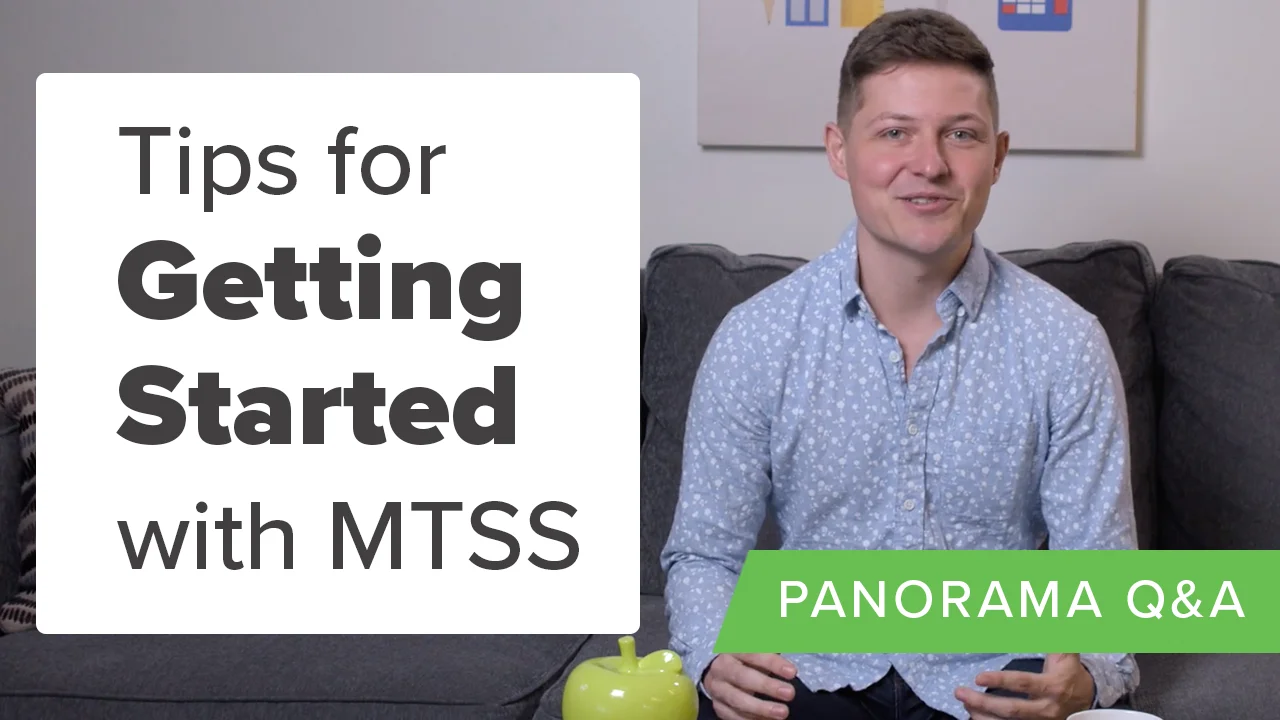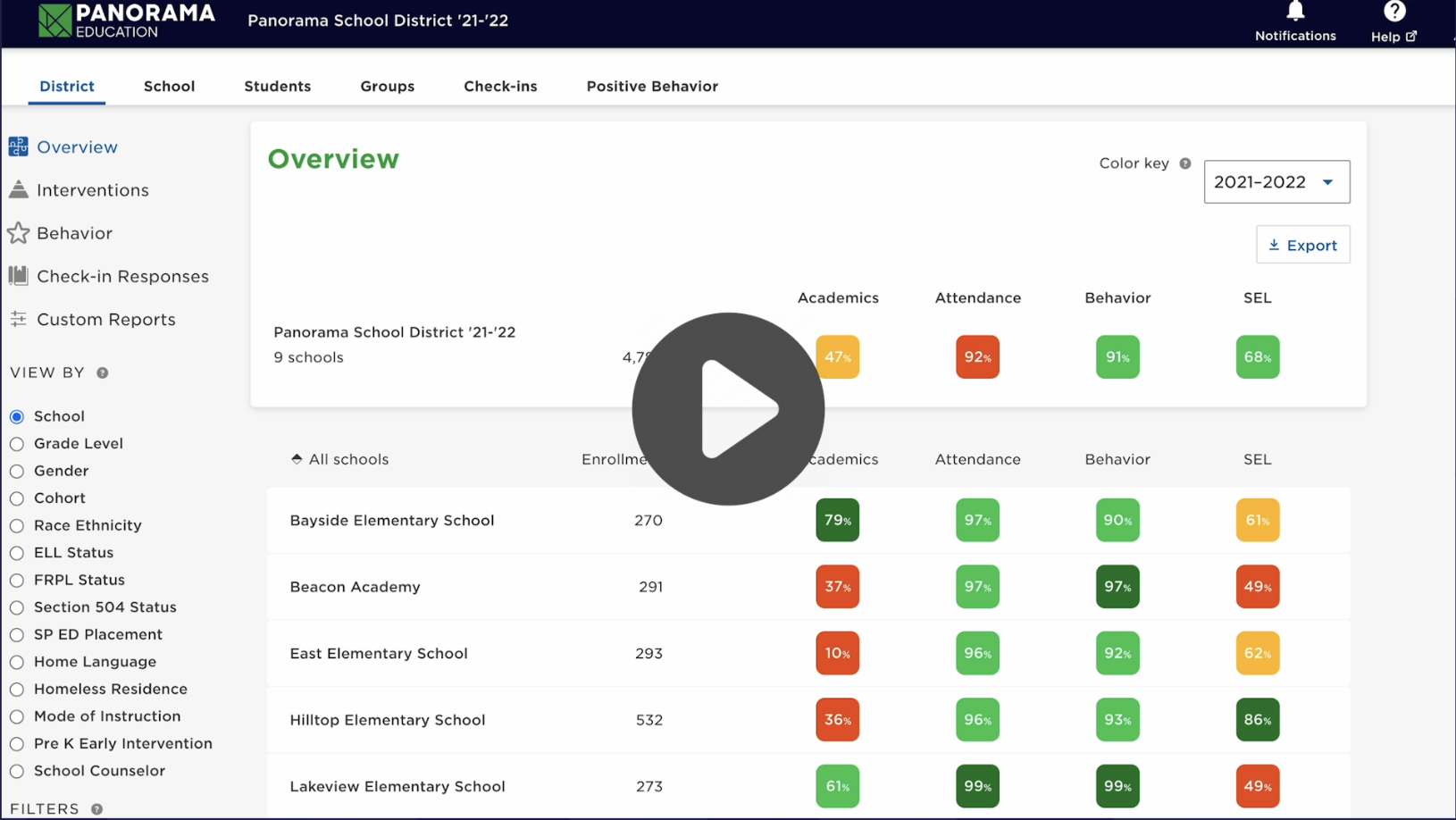"We're transitioning to an MTSS model. What are the key things to think about when getting started?"
This is one of the most common questions we hear from schools and districts who are just beginning their journeys with a multi-tiered system of supports (MTSS)—or even those who are a few years in and looking to improve their processes.
We know it can be daunting to roll out MTSS initiatives, so we're breaking it down into three parts:
- Set a clear vision for MTSS and document it
- Build human systems
- Invest in data systems
Watch the first episode of Panorama Q&A below or on YouTube to hear tips for getting started with MTSS, or keep reading for a brief introduction to MTSS, an explanation of the three elements for successful MTSS rollout in the first year, and a story about how one school district rolled out its MTSS.

What Does MTSS Mean?
MTSS stands for Multi-Tiered System of Supports. It’s a multi-level model for addressing student needs across academics, behavior, attendance, and social-emotional learning. An MTSS framework is an umbrella large enough that it can include positive behavioral interventions and supports (PBIS), response to intervention (RTI), social-emotional learning (SEL), attendance, family-school partnerships, and community partnerships.
A strong MTSS can help identify students who would otherwise fly under the radar, determine the right supports for a particular student, get students the support they need sooner, and consistently carry out supports to meet the needs of all students and ensure they receive a high-quality education.
What Are the Three Tiers of MTSS?
MTSS is made up of three levels of support known as tiers: Tier 1 universal supports, Tier 2 targeted supports, and Tier 3 intensive supports.
All students school-wide should receive Tier 1 supports such as core instruction or access to a positive climate for learning. Tier 2 supports are delivered to struggling students as needed in groups such as small group reading instruction or after-school tutoring. Tier 3 supports should only be employed when the other tiers aren’t working, and involve one-on-one support tailored to an individual student.
3 Elements for Successful MTSS Rollout
1. Set a vision for MTSS and document it
First—and this may sound obvious—it’s important to set a vision and document it. Have a public written plan that shares your core beliefs, goals, and definitions around MTSS. Maybe you’re focusing on MTSS as a pathway to equity, as a framework for supporting the whole child, as a way to provide proactive, personalized support to every student—or all of the above.
A key goal of this plan should be to ensure that staff are using shared language around MTSS. When I was a principal, I supported my staff with student-first language to describe the observable needs and strengths of students.
For example, rather than staff using deficit-based phrases like "lazy student," saying “this student struggles with motivation when reading above-grade-level text.” Or, rather than “Carla needs to work on her fluency,” saying, “Carla is reading 72 words per minute and consistently missing two-syllable words and the sight word ‘was’.”
2. Build human systems
We know that having shared language and a clear vision isn’t enough. Your plan can be flawless, but you need to have the people to execute on it. MTSS is a team sport; everyone in the building has a role in making it work. As leaders, we need to build human systems to weave the MTSS process into our school culture.
This means creating central office positions that align with your strategic vision for MTSS, creating shared protocols, building time for MTSS into master schedules, and offering professional development. Many districts hire for full-time MTSS roles to focus on leadership and collaboration on MTSS implementation across a school or district.
3. Invest in data systems
At the heart of MTSS are strong data systems. Your support staff needs real-time access to student data for decision-making about student supports, and you’ve got to have data to understand student progress and assess if intervention strategies are working.
Think about ways to streamline intervention management. We recommend bringing your progress monitoring data across academics, behavior, attendance, and social-emotional learning (SEL) into one spot instead of having it in different systems, spreadsheets, and reports. Panorama can help you with that: Our MTSS software platform brings all your data together with intervention tracking dashboards and easy-to-use tools for managing interventions.
|
Want to learn more? Check out our 3-minute demo of Panorama Student Success |
Mehlville School District (MO) and St. Louis County's Special School District is an example of a strong partnership with Panorama to implement MTSS and support learners at every tier, inclusive of those receiving special education services.
Adam Smith, Executive Director of Student Services at Mehlville School District said, "We used to spend our meeting times gathering data through spreadsheets and paper folders. Then we would need to schedule another meeting to actually talk about the data. Now, we spend our time problem-solving around data and making decisions to plan interventions to support students. The efficiency piece is really powerful."







